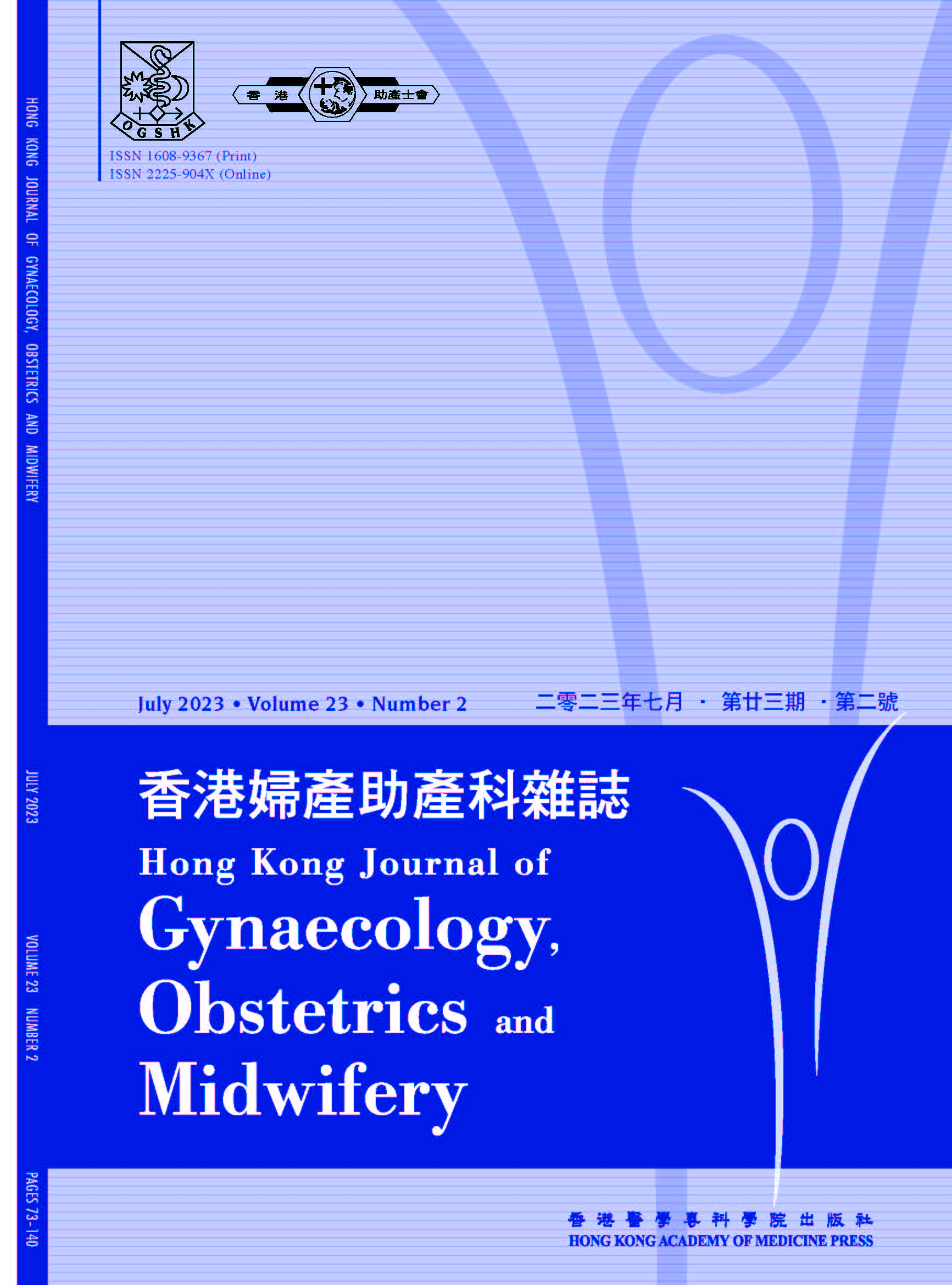Patient acceptability and satisfaction for hysteroscopic morcellation
DOI:
https://doi.org/10.12809/hkjgom.23.2.344Keywords:
Hysteroscopy, Morcellation, Patient satisfaction, Safety, Treatment outcomeAbstract
Objective: To evaluate patients’ pain scores and satisfaction with hysteroscopic morcellation service in two hospitals in Hong Kong.
Methods: Medical records of women who underwent hysteroscopic morcellation as a day procedure using the Intrauterine Bigatti Shaver between 1 November 2018 and 31 October 2022 at Tuen Mun Hospital or Pok Oi Hospital were retrospectively reviewed.
Results: 242 patients who underwent hysteroscopic morcellation were included. The mean patient age was 54.1 years. Postmenopausal bleeding was the commonest presenting symptom (48.8%), followed by abnormal menstrual bleeding (42.6%). 43.8% of patients had one lesion; 87.2% of patients had endometrial polyps. There were 523 endometrial polyps and 29 myomas; 99.4% of endometrial polyps and 79.3% of myomas were removed. The complete resection rate was higher for patients with endometrial polyps than for patients with myomas (98.7% vs 77.8%, p<0.001). Most patients reported mild pain intraoperatively (57.4%), immediately after the procedure (72.3%), and upon discharge (95.0%). 98.8% of patients were satisfied with the procedure; 94.2% would undergo the same operation again if clinically indicated; and 95.5% would recommend this procedure to others. Premenopausal women reported more pain immediately after the procedure (2 vs 1, p=0.020) and upon discharge (0 vs 0, p=0.040) than postmenopausal women. Patients with an operative time of >20 minutes reported more pain immediately after the procedure (3 vs 1, p=0.007) than patients with an operative time of ≤20 minutes.
Conclusion: Almost all patients were satisfied with hysteroscopic morcellation. Most patients experienced only mild pain during and immediately after the procedure and upon discharge. Premenopausal status and operative time of >20 minutes were associated with higher pain scores. Further optimisation of pain-relief methods should be considered.
References
Stewart EA. Uterine fibroids. Lancet 2001;357:293-8. DOI: https://doi.org/10.1016/S0140-6736(00)03622-9
American Association of Gynecologic Laparoscopists. AAGL practice report: practice guidelines for the diagnosis and management of endometrial polyps. J Minim Invasive Gynecol 2012;19:3-10. DOI: https://doi.org/10.1016/j.jmig.2011.09.003
Touboul C, Fernandez H, Deffieux X, Berry R, Frydman R, Gervaise A. Uterine synechiae after bipolar hysteroscopic resection of submucosal myomas in patients with infertility. Fertil Steril 2009;92:1690-3. DOI: https://doi.org/10.1016/j.fertnstert.2008.08.108
Hamerlynck TW, Schoot BC, van Vliet HA, Weyers S. Removal of endometrial polyps: hysteroscopic morcellation versus bipolar resectoscopy: a randomized trial. J Minim Invasive Gynecol 2015;22:1237-43. DOI: https://doi.org/10.1016/j.jmig.2015.07.006
Hamerlynck TW, Dietz V, Schoot BC. Clinical implementation of the hysteroscopic morcellator for removal of intrauterine myomas and polyps. A retrospective descriptive study. Gynecol Surg 2011;8:193-6. DOI: https://doi.org/10.1007/s10397-010-0627-7
Li C, Dai Z, Gong Y, Xie B, Wang B. A systematic review and meta-analysis of randomized controlled trials comparing hysteroscopic morcellation with resectoscopy for patients with endometrial lesions. Int J Gynaecol Obstet 2017;136:6-12. DOI: https://doi.org/10.1002/ijgo.12012
Shazly SA, Laughlin-Tommaso SK, Breitkopf DM, et al. Hysteroscopic morcellation versus resection for the treatment of uterine cavitary lesions: a systematic review and meta-analysis. J Minim Invasive Gynecol 2016;23:867-77. DOI: https://doi.org/10.1016/j.jmig.2016.04.013
Scheiber MD, Chen SH. A prospective multicenter registry of patients undergoing hysteroscopic morcellation of uterine polyps and myomas. J Gynecol Surg 2016;32:318-23. DOI: https://doi.org/10.1089/gyn.2016.0008
Pampalona JR, Bastos MD, Moreno GM, et al. A comparison of hysteroscopic mechanical tissue removal with bipolar electrical resection for the management of endometrial polyps in an ambulatory care setting: preliminary results. J Minim Invasive Gynecol 2015;22:439-45. DOI: https://doi.org/10.1016/j.jmig.2014.12.004
Emanuel MH, Wamsteker K. The intra uterine morcellator: a new hysteroscopic operating technique to remove intrauterine polyps and myomas. J Minim Invasive Gynecol 2005;12:62-6. DOI: https://doi.org/10.1016/j.jmig.2004.12.011
Murakami T, Tamura M, Ozawa Y, Suzuki H, Terada Y, Okamura K. Safe techniques in surgery for hysteroscopic myomectomy. J Obstet Gynaecol Res 2005;31:216-23. DOI: https://doi.org/10.1111/j.1447-0756.2005.00274.x
Ma T, Readman E, Hicks L, et al. Is outpatient hysteroscopy the new gold standard? Results from an 11 year prospective observational study. Aust N Z J Obstet Gynaecol 2017;57:74-80. DOI: https://doi.org/10.1111/ajo.12560
Pervaiz Z, Korrapati S, Ghoubara A, Ewies A. Office hysteroscopic morcellation service: evaluation of women experience and factors affecting satisfaction. Eur J Obstet Gynecol Reprod Biol 2021;264:294-8.
Wortman M, Daggett A, Ball C. Operative hysteroscopy in an office-based surgical setting: review of patient safety and satisfaction in 414 cases. J Minim Invasive Gynecol 2013;20:56-63. DOI: https://doi.org/10.1016/j.jmig.2012.08.778
Agostini A, Bretelle F, Cravello L, Maisonneuve AS, Roger V, Blanc B. Acceptance of outpatient flexible hysteroscopy by premenopausal and postmenopausal women. J Reprod Med 2003;48:441-3.
McIlwaine P, McElhinney B, Karthigasu KA, Hart R. A prospective study of the use of the Myosure resectoscope to manage endometrial polyps in an outpatient setting. Aust N Z J Obstet Gynaecol 2015;55:482-6. DOI: https://doi.org/10.1111/ajo.12382
Di Spiezio Sardo A, Florio P, Fernandez LM, et al. The potential role of endometrial nerve fibers in the pathogenesis of pain during endometrial biopsy at office hysteroscopy. Reprod Sci 2015;22:124-31. DOI: https://doi.org/10.1177/1933719114534536
Hysteroscopy, Best Practice in Outpatient (Green Top Guideline No. 59). Available at: https://www.rcog.org.uk/guidance/browse-all-guidance/green-top-guidelines/hysteroscopy-best-practice-in-outpatient-green-top-guideline-no-59/
Law HY, Ng DYT, Chung CD. Use of music in reducing pain during outpatient hysteroscopy: prospective randomized trial. J Obstet Gynaecol Res 2021;47:904-12.
Sorrentino F, Petito A, Angioni S, et al. Impact of anxiety levels on the perception of pain in patients undergoing office hysteroscopy. Arch Gynecol Obstet 2021;303:999-1007.
Keogh SC, Fry K, Mbugua E, et al. Vocal local versus pharmacological treatments for pain management in tubal ligation procedures in rural Kenya: a non-inferiority trial. BMC Womens Health 2014;14:21. DOI: https://doi.org/10.1186/1472-6874-14-21
Georgiou D, Tranoulis A, Jackson TL. Hysteroscopic tissue removal system (MyoSure) for the resection of polyps, sub-mucosal leiomyomas and retained products of conception in an out-patient setting: a single UK institution experience. Eur J Obstet Gynecol Reprod Biol 2018;231:147-51.
Downloads
Published
How to Cite
Issue
Section
License
Copyright (c) 2023 Hong Kong Journal of Gynaecology, Obstetrics and Midwifery

This work is licensed under a Creative Commons Attribution-NonCommercial-NoDerivatives 4.0 International License.
The Journal has a fully Open Access policy and publishes all articles under a Creative Commons Attribution-NonCommercial-NoDerivatives 4.0 International (CC BY-NC-ND 4.0) licence. For any use other than that permitted by this license, written permission must be obtained from the Journal.









